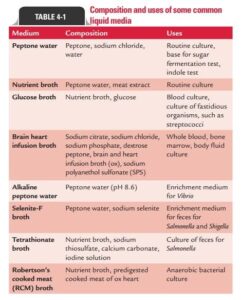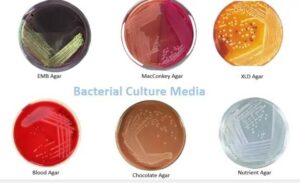Back to: MICROBIOLOGY 100 LEVEL
Welcome to class!
Hello, my brilliant learner! I’m so glad you’re here again, ready to learn more about the fascinating world of microbiology. Today, we’ll be talking about types of media and nutritional types—that is, how scientists grow bacteria in the lab and how different bacteria get their food to survive. Think of it like preparing the perfect meal or environment for different kinds of guests. Ready to become a microbiologist chef? Let’s get started!
Types Of Media And Nutritional Types
Types of Media
In microbiology, media are the special foods or environments prepared to help bacteria and other microorganisms grow. Just like you need the right ingredients to make your favourite jollof rice or pounded yam, bacteria need the right mix of nutrients to grow well.

Media can be classified into different types:
Physical State
Solid Media: This contains a substance called agar, a jelly-like material from seaweed, which makes the media firm. It’s like a plate where bacteria can grow into colonies you can see. For example, nutrient agar is commonly used to grow many bacteria.
Liquid Media (Broth): This is like a soup where bacteria float and multiply. It’s good for growing lots of bacteria quickly.
Semi-solid Media: This is between solid and liquid and is often used to test if bacteria can move or to grow bacteria that like less oxygen.
Chemical Composition
Defined (Synthetic) Media: Scientists know exactly what’s in these media. Every ingredient is measured carefully. It’s like baking with a strict recipe—this helps when studying bacteria’s exact nutritional needs.
Complex (Non-synthetic) Media: These have ingredients like yeast extract, blood, or meat extracts, but the exact chemical makeup isn’t known. This is more like cooking with stock or broth where the full recipe isn’t exact.
Functional Types
Selective Media: These help grow only certain types of bacteria by containing substances that stop unwanted bacteria. For example, media with antibiotics may only allow resistant bacteria to grow.
Differential Media: These show differences between bacteria by changing colour or appearance. For example, MacConkey agar helps tell apart bacteria that can break down lactose from those that cannot.
Nutritional Types of Microorganisms
Just like people, different bacteria have different ways of getting their food and energy. Based on this, scientists classify them into nutritional types:
Autotrophs
These bacteria make their own food from simple substances like carbon dioxide. It’s like a plant using sunlight to cook its own food during photosynthesis. Some bacteria do this too!
Heterotrophs
These bacteria get their food by eating other organisms or organic matter. Most bacteria that cause infections are heterotrophs—they feed on things like sugars, proteins, and fats from their environment.
Phototrophs
These use light as their energy source. Like sun-loving plants, phototrophic bacteria harvest sunlight to power their growth.
Chemotrophs
These bacteria get energy by breaking down chemical substances, sometimes from minerals or inorganic compounds.
Saprophytes
These feed on dead or decaying matter. Imagine bacteria helping to clean up the environment by breaking down waste.

Parasites
These bacteria live on or inside other living organisms (like humans or animals) and get their nutrients from their host. Some parasites cause diseases.
Think of a restaurant with different customers: some want a vegetarian meal (autotrophs), others want meat (heterotrophs), some prefer fast food (saprophytes), and some might sneak in and take food without paying (parasites). To serve all these customers, the kitchen must prepare different dishes (media) suited for each type.
Summary
- Media are special food and environments prepared to grow bacteria, coming in solid, liquid, or semi-solid forms.
- Media can be defined or complex and also selective or differential, depending on the purpose.
- Bacteria are classified by how they get food: autotrophs (make their own), heterotrophs (eat others), phototrophs (use light), chemotrophs (use chemicals), saprophytes (feed on dead matter), and parasites (live off hosts).
Evaluation
- What is the difference between solid and liquid media?
- Why are selective media useful in microbiology?
- What nutritional type uses light as an energy source?
- Give an example of a parasite in bacteria.
- Why do scientists use defined media?
Your understanding of how bacteria grow and survive is growing strong. Keep this curiosity alive, and remember Afrilearn is always here to help you shine brighter. Can’t wait to see you next time for more exciting learning!
